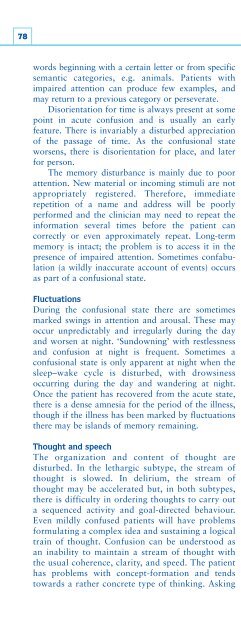Create successful ePaper yourself
Turn your PDF publications into a flip-book with our unique Google optimized e-Paper software.
78words beginning with a certain letter or from specificsemantic categories, e.g. animals. Patients withimpaired attention can produce few examples, andmay return to a previous category or perseverate.Disorientation for time is always present at somepoint in acute confusion and is usually an earlyfeature. There is invariably a disturbed appreciationof the passage of time. As the confusional stateworsens, there is disorientation for place, and laterfor person.The memory disturbance is mainly due to poorattention. New material or incoming stimuli are notappropriately registered. Therefore, immediaterepetition of a name and address will be poorlyperformed and the clinician may need to repeat theinformation several times before the patient cancorrectly or even approximately repeat. Long-termmemory is intact; the problem is to access it in thepresence of impaired attention. Sometimes confabulation(a wildly inaccurate account of events) occursas part of a confusional state.FluctuationsDuring the confusional state there are sometimesmarked swings in attention and arousal. These mayoccur unpredictably and irregularly during the dayand worsen at night. ‘Sundowning’ with restlessnessand confusion at night is frequent. Sometimes aconfusional state is only apparent at night when thesleep–wake cycle is disturbed, with drowsinessoccurring during the day and wandering at night.Once the patient has recovered from the acute state,there is a dense amnesia for the period of the illness,though if the illness has been marked by fluctuationsthere may be islands of memory remaining.Thought and speechThe organization and content of thought aredisturbed. In the lethargic subtype, the stream ofthought is slowed. In delirium, the stream ofthought may be accelerated but, in both subtypes,there is difficulty in ordering thoughts to carry outa sequenced activity and goal-directed behaviour.Even mildly confused patients will have problemsformulating a complex idea and sustaining a logicaltrain of thought. Confusion can be understood asan inability to maintain a stream of thought withthe usual coherence, clarity, and speed. The patienthas problems with concept-formation and tendstowards a rather concrete type of thinking. Askingthe patient to explain a proverb such as ‘a rollingstone gathers no moss’ can test this. The cliniciancan test to see whether the patient can detectdifferences and similarities between classes ofobject (similarity judgement), and whether they candefine single words.Sometimes, the thought content has a dream-likequality and it may be dominated by the patient’sconcerns, beliefs, and desires. There are often brief,poorly elaborated, and inconsistent delusions whichhave a paranoid content, such as that their life is indanger or that relatives have been killed.The patient’s speech may reflect this muddledthinking, in that it is imprecise, shifting from subjectto subject, is usually circumlocutory and goes off at atangent. There are hesitations, repetitions, andperseverations. Often the rate is abnormal andhurried with a dysarthria.Perceptual deficitsPerception refers to the ability to extract appropriateinformation from the environment and one’s ownbody and to integrate this information so that it canbe useful and is meaningful. Clearly an attentiondeficit accounts for many of the perceptualdisturbances; the most common disturbance isdecreased perception: the patients are missing thingsgoing on around them. However, there may bedisturbances of vision and hearing, visualhallucinations occurring particularly in the youngerpatient. These are vivid and coloured. Sounds may bedistorted or accentuated. Body image may be affectedwith a perceived alteration of size or shape. Feelingsof unreality and depersonalization are common, butpsychotic auditory hallucinations with voicescommenting on behaviour do not generally occur inthe acute confusional state. Generally, patients withdelirium rather than the lethargic subtype develophallucinations and those patients who are alcohol- orbenzodiazepine- dependent and have been withdrawnfrom them are particularly likely to hallucinate.There are some additional perceptual phenomenaworth mentioning: an altered time sense whennonrelated events are juxtaposed. Sometimes theunfamiliar is mistaken for the familiar. Bizarrereduplicative phenomena may occur, when a patientperceives a person with two heads but one body.Similarly, reduplicative paramnesia, or the replacementof persons or places, occurs because of an inability tointegrate recent observations with past memories.
















